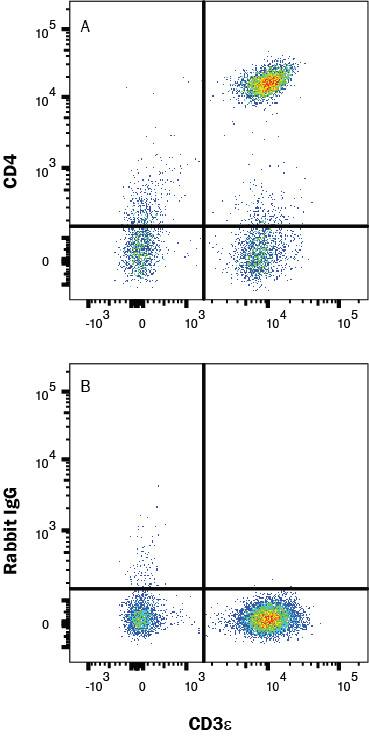Human CD4 MAb (Clone 2759D)
R&D Systems, part of Bio-Techne | Catalog # MAB37914
Recombinant Monoclonal Antibody.


Conjugate
Catalog #
Key Product Details
Species Reactivity
Human
Applications
Flow Cytometry
Label
Unconjugated
Antibody Source
Recombinant Monoclonal Rabbit IgG Clone # 2759D
Product Specifications
Immunogen
Spodoptera frugiperda, Sf 21 (baculovirus)-derived human CD4
Lys26-Trp390
Accession # P01730.1
Lys26-Trp390
Accession # P01730.1
Specificity
Detects human CD4 in direct ELISAs
Clonality
Monoclonal
Host
Rabbit
Isotype
IgG
Scientific Data Images for Human CD4 MAb (Clone 2759D)
Detection of CD4 in Human PBMC Lymphocytes by Flow Cytometry.
Human PBMC were stained with (A) Rabbit Anti-Human CD4 Monoclonal Antibody (Catalog # MAB37914) or (B) Rabbit IgG Control (MAB1050), followed by PE-conjugated anti-Rabbit IgG secondary antibody (F0110) and Mouse Anti-Human CD3 epsilon APC-conjugated Monoclonal Antibody (FAB100A). Staining was performed using our Staining Membrane-associated Proteins protocol.Applications for Human CD4 MAb (Clone 2759D)
Application
Recommended Usage
Flow Cytometry
0.25 µg/106 cells
Sample: Human PBMC lymphocytes
Sample: Human PBMC lymphocytes
Formulation, Preparation, and Storage
Purification
Protein A or G purified from hybridoma culture supernatant
Reconstitution
Reconstitute at 0.5 mg/mL in sterile PBS. For liquid material, refer to CoA for concentration.
Formulation
Lyophilized from a 0.2 μm filtered solution in PBS with Trehalose. *Small pack size (SP) is supplied either lyophilized or as a 0.2 µm filtered solution in PBS.
Shipping
Lyophilized product is shipped at ambient temperature. Liquid small pack size (-SP) is shipped with polar packs. Upon receipt, store immediately at the temperature recommended below.
Stability & Storage
Use a manual defrost freezer and avoid repeated freeze-thaw cycles.
- 12 months from date of receipt, -20 to -70 °C as supplied.
- 1 month, 2 to 8 °C under sterile conditions after reconstitution.
- 6 months, -20 to -70 °C under sterile conditions after reconstitution.
Background: CD4
References
- Vignali, D.A.A. (2010) J. Immunol. 184:5933.
- Maddon, P.J. et al. (1985) Cell 42:93.
- Alarcon, B. and H.M. van Santen (2010) Sci. Signal. 3:pe11.
- Wan, Y.Y. and R.A. Flavell (2009) Mol. Cell Biol. 1:20.
- Kitchen, S.G. et al. (2005) Proc. Natl. Acad. Sci. 102:3794.
- Crocker, P.R. et al. (1987) J. Exp. Med. 166:613.
- Biswas, P. et al. (2003) Blood 101:4452.
- Bernstein, H.B. et al. (2006) J. Immunol. 177:3669.
- Funke, I. et al. (1987) J. Exp. Med. 165:1230.
- Doyle, C. and J.L. Strominger (1987) Nature 330:256.
- Huppa, J.B. et al. (2010) Nature 463:963.
- Fragoso, R. et al. (2003) J. Immunol. 170:913.
- Cruikshank, W.W. et al. (1994) Proc. Natl. Acad. Sci. 91:5109.
- Klatzmann, D. et al. (1984) Nature 312:767.
- Dagleish, A.G. et al. (1984) Nature 312:763.
Alternate Names
CD4
Entrez Gene IDs
Gene Symbol
CD4
UniProt
Additional CD4 Products
Product Documents for Human CD4 MAb (Clone 2759D)
Product Specific Notices for Human CD4 MAb (Clone 2759D)
For research use only
